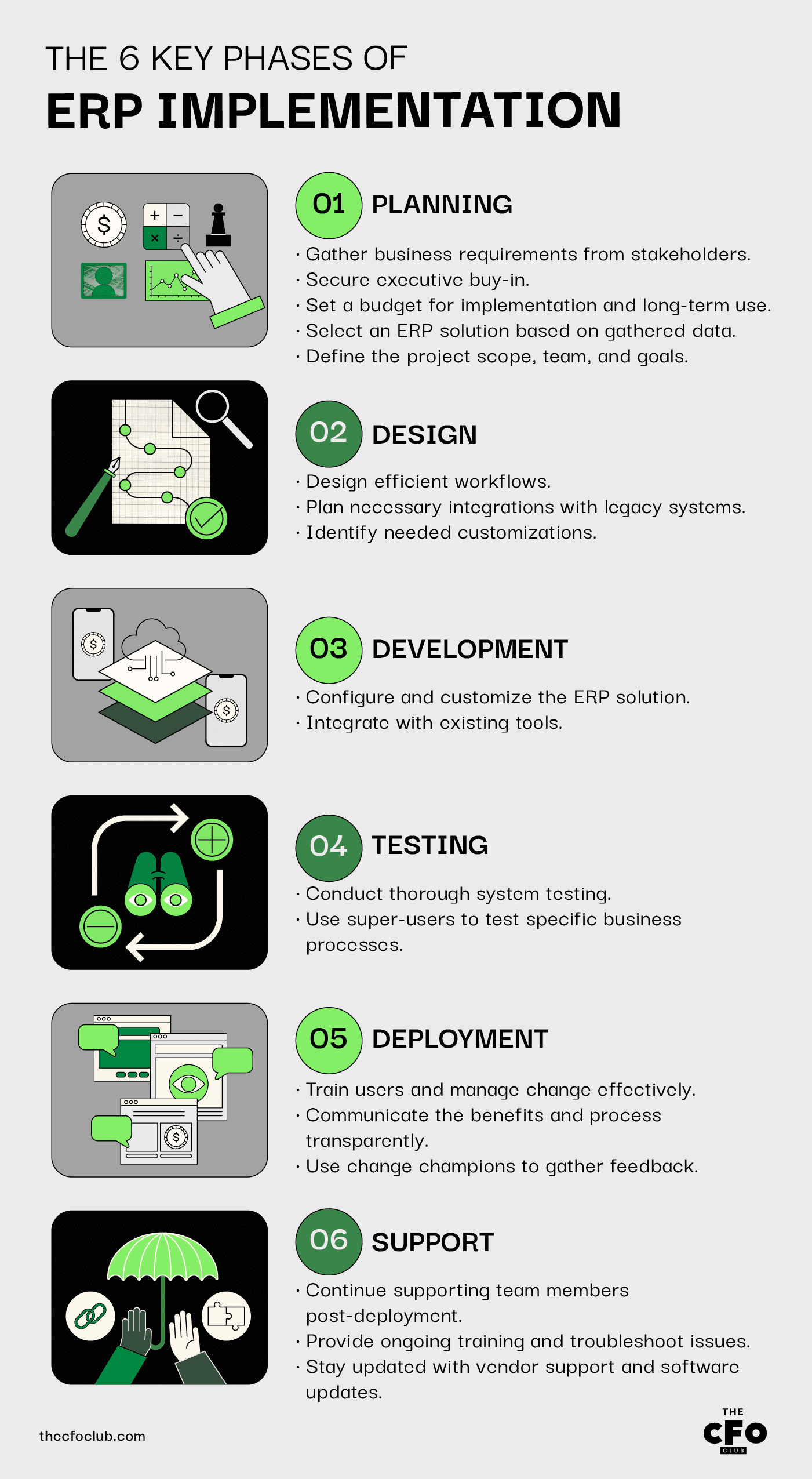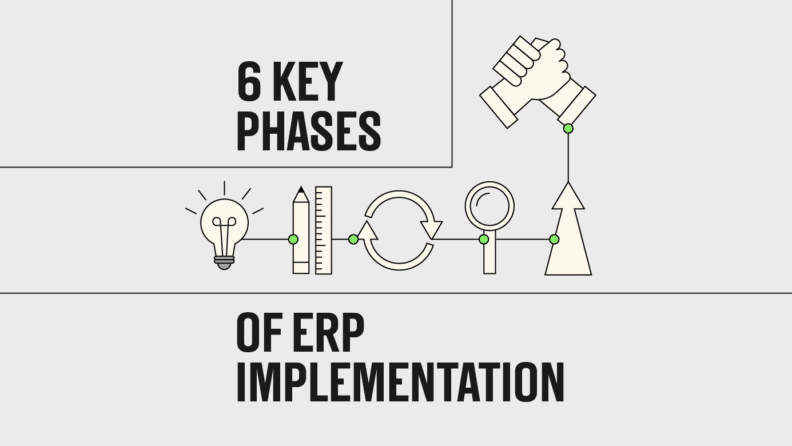Always Have a Plan: A well-defined plan prevents 'project-based chaos,' ensuring clarity, alignment, and agility throughout ERP implementation.
Know Your Integrations: Consider all of the integrations your ERP will need to run smoothly, as well as any other processes or customizations you'll need.
Building a Strong Implementation Dream Team: Successful ERP deployment requires the right mix of internal and external sources, involving everyone from software teams to stakeholders.
Maintain Your Software: The buck doesn't stop at implementation. Make sure to update, test, and improve your ERP regularly to keep up with business changes.
ERP implementation isn’t just another IT project—it’s a game-changer for your entire business. Done right, it provides several benefits, such as streamlined operations, improved data accuracy, and increased work more efficiently.
But without a solid plan, an ERP rollout can quickly turn into a costly headache, filled with delays, frustrated employees, and blown budgets. That’s why a well-executed implementation is key to making sure your ERP system delivers the ROI you expect.
Having worked extensively in fintech and digital software, I’ve seen what makes ERP implementations succeed—and where they go off the rails.
That's why I created this guide. Whether you’re choosing a new system or optimizing an existing one, I’ll walk you through the key steps, best practices, and potential roadblocks to watch out for.
The goal? To help you implement your ERP smoothly, stay on budget, and make sure your team actually benefits from the system—not fights against it.
What is ERP Implementation?
ERP implementation encompasses all the work required to bring the right ERP solution into your business, starting with selecting software and ending with a fully functional system (and a happy organization).
You'll have to go through the implementation process whether you're:
- Starting fresh and implementing your org's first ERP system,
- Changing ERP systems—say from an on-prem to a cloud-based provider, or
- Coming into an organization with a severely under-utilized system
Why Do I Need a Plan?
Gartner is on record saying that 55% of ERP implementations fail to meet the objectives of the project. Why? Largely, because of a little thing I call project-based chaos.
Creating—and sticking to—a clear plan eliminates project-based chaos for the following reasons:
Keeps People on the Same Page
Scope creep is a common reason for failure when implementing an ERP. You may set out to address some specific functionality or business processes but end up seeking to meet ever-expanding demands as more people weigh in.
A written implementation plan helps point stakeholders and others back to true north for the project, and help gets you home in time for dinner.
Makes You Consider the Big Picture
Many businesses turn to ERPs to streamline and connect processes from different—often disparate—areas of the business. Understanding your organization’s change management requirements and the needs of all related business units helps inform decision-making throughout the implementation process.
Written Plans Can Be Edited
When you have a plan, you can make careful, data-backed decisions to change it. That provides some agility throughout implementation, whether or not you have a dedicated project manager overseeing it.
Without a plan, organizations may make many on-the-fly decisions that aren’t as carefully considered and lead to lackluster results.
What Type of Implementation Project Do I Have?
One of the first steps in creating a viable plan for your implementation project is understanding what type of effort you’re undertaking. Some implementations can be completed in a few weeks or months by an ERP consultant, while others take more than a year of input from internal team members; it all comes down to the type of project.
Here’s a look at a few common ERP implementation types:
- On-premises to cloud ERP migration. This involves moving from an on-premises solution to one that’s based in the cloud. You might implement cloud storage or other features from your existing ERP vendor or migrate everything to a product from a new vendor.
- Cloud-to-cloud data migration. With this implementation, you are moving from one cloud-based ERP system to another. You may be migrating data only, leaving your team working in the same interface they always have or you might need to roll out a new interface and train your team to use it.
- CRM to ERP switch. In some cases, ERP implementation involves switching from a different solution to an ERP model, such as migrating from an existing customer relationship management tool to an ERP tool. Or, you might want to migrate from numerous disparate accounting, human resource, and customer management systems to a single system and source of truth.
- Completely new software implementation. In some cases, businesses don’t have existing software solutions, and they are embarking on a totally new implementation.
Successful ERP implementation requires the right resources on your project team, so talk to your vendor or implementation partner to understand what kind of effort you’re looking at. Then, you can choose internal resources that match the required work and necessary skills.
The 6 Key Phases of ERP Implementation

Some factors that commonly keep organizations from achieving ERP implementation success include a lack of clear goals and direction, poor planning, inappropriate resource allocation, and poor buy-in.
Embarking on your project with the right methodology and a clear understanding of the implementation phases can help you avoid these pitfalls.
1. Planning
The first phase of your implementation covers research and decision-making. It should include:
- Gathering business requirements. Meet with all impacted stakeholders and selected subject-matter experts to understand the business needs for any solution you choose. Make sure that they're notified of each step as you implement your ERP.
- Getting buy-in from up high. If you aren't the final decision-maker involved here, you know that the project could be dead in the water unless you have the right signatures. Get them onboard as soon as a plan is in place.
- Setting a budget. Decide (or figure out) how much you can spend on the initial implementation work, as well as long-term on the solution.
- Selecting a solution. Use the data gathered in the previous steps to evaluate potential vendors and ERP solutions. Choose one that best meets your needs.
- Define your implementation project. Choose an internal project team, define which business processes are relevant and how the solution will impact them, and set specific goals that define what success looks like for your project.
2. Design
Working with the goals defined in phase one, your project team and implementation partner will design a new ERP system. The extent of the design work depends on a variety of factors, including whether you’re opting for a solution with out-of-the-box functionality, an option with various modules that can be customized to meet your needs, or a from-scratch software development.
Regardless of the type of project you’re embarking on, it’s important to take time during this phase to:
- Design workflows that capture existing and desired business processes in the most efficient manner possible
- Consider necessary integrations with legacy systems
- Dig deep into the unique needs of your processes and teams to define any customizations that might be necessary
3. Development
During the development phase of an ERP implementation project, the team does the work that was defined in the design phase.
In some cases, this might require developing and coding new tools. Most of the time though, when working with a vendor and an existing ERP solution, development is more about configuring resources, customizing them where necessary, and integrating them with your existing tools.
-

FreshBooks
Visit WebsiteThis is an aggregated rating for this tool including ratings from Crozdesk users and ratings from other sites.4.5 -

BlackLine
Visit WebsiteThis is an aggregated rating for this tool including ratings from Crozdesk users and ratings from other sites.4.5 -

Xledger
Visit WebsiteThis is an aggregated rating for this tool including ratings from Crozdesk users and ratings from other sites.4.5
4. Testing
The implementation team needs to be on the ball here, ensuring ample system testing occurs throughout development and through deployment.
The TLDR of that article: You need (knowledgeable) people to look at each element of your operations affected by the ERP system and make sure nothing's broken. You'll likely utilize a mixture of internal & vendor resources for user testing, with project managers (aka, probably you) overseeing the whole thing.
Ultimately, it’s a good idea to get super-users within your organization to put processes through their paces:
- Have someone in accounting testing ledger entry, invoicing, and AR capabilities.
- Ask someone in human resources to test recruiting, onboarding, and employee management functions.
- If you listed a business process in the planning stage and built it into the ERP, someone needs to test it.
This stage also includes the planning and execution of data migration. Before testing the ERP, the software team will simultaneously (and painstakingly) extract, transform, and load data from multiple other systems into your new ERP.
This generally includes customer, client, vendor, and item records, bills of materials, routing information, general ledger charts of accounts, and more. Any redundant or old data will be filtered out and wiped to ensure a smooth transition.
5. Deployment
After testing — and addressing any bugs that come up during that process — you’re ready to deploy your new solution.
To enhance buy-in, invest time and resources in user training. With the right documentation and materials, you can help users easily adapt to the new software. If possible, it also may be a good idea to have a vendor training rep come to your location to provide ongoing support during the initial rollout.
Along with these strategies, consider following these change management steps:
- Spend time in the weeks leading up to the final deployment communicating about the implementation to your entire team.
- Pose the new resource as a positive for everyone and let people know how you believe it can help them.
- Be transparent about the implementation process and let your team know that hiccups are completely normal.
Overall, these change management strategies will help reduce the chance that people will become frustrated as you work through any initial challenges. In this stage, it’s also helpful to have “change champions” within different departments, who can collect and deliver feedback on the product after it’s been rolled out.
6. Support
Once the ERP is being used across all functional teams seamlessly, the project is a success, the hard work is finished. But don’t disband your implementation team right after deployment.
This team will not only be vital in supporting your users, but they'll also be readily available for any troubleshooting processes or errors that occur. Remember that like with any system, ongoing maintenance and aid will be necessary, especially as changes occur in your business.
Selecting an ERP System
Choosing the right ERP system is, of course, one of the most important steps in ensuring a successful implementation. Consider the following key factors when selecting an ERP system:
- Business Requirements: Make sure to have a detailed list of requirements to guide your selection process. I recommend collecting "nice to have" and elements alongside your "need to haves", so you know what else to ask about if you have two good vendors.
- Scalability: Choose a system that can grow with your business. As you know, putting one of these systems in place takes a long time and a lot of effort—do future you a favor and pick something that'll last.
- Integration Capabilities: Ensure the ERP system can integrate with your existing software and technology stack. You'll be replacing a lot of tools, but you need to fit the other ones in nicely too.
- User-Friendliness: You'd be surprised how big a profitability hit organizations face when training their employees on new software. A user-friendly interface reduces the learning curve for employees—aka, helps you make more money, quicker.
- Vendor Reputation: Research potential vendors thoroughly. Look for reviews, case studies, and testimonials to gauge their reliability and customer support.
- Cloud vs. On-Premise: Cloud ERPs allow your team to access your software from anywhere, which could be handy in construction or manufacturing businesses. On-premise ERP software, on the other hand, is limited, only allowing access from a central location, which may be more beneficial for retail.
- Cost: Consider both the initial investment and the long-term costs associated with the ERP system. Evaluate the total cost of ownership, including maintenance and upgrade expenses.
Here are some of my top picks to help you get started. Most vendors offer demos to help businesses determine if their solution will fit their specific needs before purchase. Consider enrolling in these offerings to ensure the ERP is the right choice for you.
ERP System Implementation Best Practices
Choosing the right ERP solution is one of the most important things you can do to ensure success with implementation. Following the phases in the guide above is another way to mitigate risks.
I'll leave you with a few quick words on real-life ERP failures, what caused them, and how you can avoid them to help you achieve success with your own ERP implementation.
- Mission Produce lost track of avocado inventory during its ERP implementation. It lost millions due to the failure. Avoid this type of issue by running mission-critical processes in your old system as well as your new system to ensure the new system works. Then, you can finalize your migration.
- J&J Snack Foods experienced knock-on effects from an implementation delay, leading to increased costs of more than $7 million. While you can’t plan for every possible outcome, taking time to plan ahead, involving key stakeholders, and creating a realistic project timeline can reduce the risk of business-critical delays.
- Leaseplan, a vehicle management company, eventually cut its losses and ended a failed attempt at an ERP development. According to Leaseplan, the scope and scale of what it planned simply didn’t work for what it and its customers actually needed. Mitigate the risks of this type of failure by working closely with subject-matter experts to define business requirements for your ERP.
Measuring Success from the Implementation Project
Measuring the success of an ERP implementation is vital to understand its impact and value. Here are key metrics to consider:
- Return on Investment (ROI): Calculate the ROI by comparing the cost of implementation with the financial gains achieved through improved efficiencies and productivity. But, of course, give your team time to get accustomed to the system before you evaluate how efficient it is.
- User Adoption Rates: Track how quickly and effectively employees are using the new system. High adoption rates typically indicate a successful implementation. If adoption rates leave room for improvement, focus on training.
- Operational Efficiency: Measure improvements in key operational processes, such as inventory management, order processing, and financial reporting.
- Data Accuracy: Assess the accuracy and consistency of data within the ERP system compared to previous methods. Enhanced data quality is a strong indicator of success.
- Customer Satisfaction: Monitor your own customer feedback and satisfaction levels. Though they aren't using it, an effective ERP system should positively impact customer service and relationships.
- Compliance and Risk Management: Ensure the ERP system helps your organization meet regulatory requirements and manage risks more effectively.
Subscribe For More ERP Insights
If you'd benefit from staying up to date on these systems, subscribe to our free newsletter for expert advice, guides, and insights from the finance leaders shaping the tech industry.






